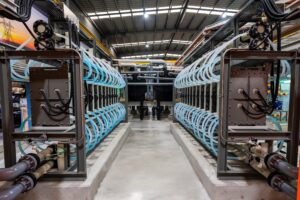
Australia’s renewable energy transition is powering ahead. The Australian Market Operator (AEMO) forecasts 90% of coal-fired power stations will be retired before 2035. Meanwhile, solar and wind is being rapidly rolled-out to meet Australia’s 2050 net zero emissions commitments.
The question now turns to how to optimise the new generation and maintain low cost, low carbon and reliable electricity supply. Without the base-load power provided by fossil fuel generators, what will happen when the sun isn’t shining, and the wind isn’t blowing?
Grid-scale Redox Flow Batteries provide a solution. As a long-duration energy storage technology they are uniquely suited to ensuring Australia reaches the 2050 net zero emissions target while maintaining electricity reliability.
Why Do We Need Long Duration Energy Storage?
The National Energy Market (NEM) is currently subject to a daily cycle whereby demand peaks during the morning and evenings. This cycle is mis-matched by solar generation which peaks at midday. As solar and wind generation continue to penetrate, new challenges have arisen. Currently, excess renewable energy is being ‘spilled’ when demand is low, and generation is high.
Energy storage provides a solution to this problem by saving excess renewable generation for dispatch when demand is high. In recent years, there has been a surge of investment in grid-scale Lithium-ion Batteries that are able to dispatch energy for 2-4 hours, providing supply for demand peaks.
However, the exit of coal-fired power from the market will dramatically change the supply dynamics. The Federal government is currently targeting 82% renewable energy by 2030, up from nearly 40% in 2023. If successful, energy storage systems capable of up to 12 hours of continuous dispatch will be required to meet daily demand.
Under AEMO’s Integrated Service Plan forecasts, based on current costs, shortfalls are to be supplemented by dispatchable gas generation. Renewable energy backed by long duration energy storage is a better pathway to meeting the net zero emissions target, while retaining grid reliability.
Redox Flow Batteries
Grid-scale Redox Flow Batteries combine the flexibility of battery technology with a long duration dispatch.
Vanadium Flow Batteries (VFB) are currently the most widely known example of this technology – although they are not the only type of flow battery emerging in this rapidly advancing field.
They can discharge up to 12 hours, providing continuous reliability support to a renewables-dominated grid. Meanwhile, their responsiveness makes them suitable for providing frequency control services to the NEM during sudden, unpredictable shifts in supply and demand.
VFB also offer specialised applications owing to their locational flexibility. Battery technology is more compact than other energy storage systems such as pumped hydro and can operate in a drought. Moreover, VFB perform optimally at a temperature range of 10 to 40 degrees Celsius meaning that, with insulation, they can be deployed in a variety of contexts. For example, as VFBs pose minimal fire risk they are safe for urban settings where they can assist in coordinating rooftop solar.
As an emerging solution, VFB currently face higher manufacturing costs than lithium-ion alternatives, however with scale these costs can come down, potentially altering the optimised path to net zero within the NEM.
The core advantage of flow batteries is their scalability. Australian Emeritus Professor Maria Skyllas-Kazacos of The University of New South Wales and her group designed and tested the first Vanadium Flow Battery in 1984. She explained that the capacity of lithium-ion Batteries can only be increased by building more battery cells. Therefore, their costs increase proportionally with their duration. In contrast, the electrolyte in VFB is liquid which makes increasing their duration a simple matter of “bigger tanks and, more electrolyte.” As duration increases, the marginal cost of VFB decline making them more cost competitive.
In addition, while Lithium-ion Battery cells need to be entirely replaced every 8-10 years, the electrolyte in a VFB lasts indefinitely allowing it to be recycled into new battery systems. Professor Skyllas-Kazacos noted “right now a lot of people fail to look past the initial capital cost,” but in long-duration contexts, the levelized cost of implementing VFB is much lower than stacking lithium-ion cells.
Other countries are exploring the potential of flow batteries. In September 2021, the U.S. Department of Energy set a ‘storage shot’ target to reduce grid-scale storage costs by 90% for systems delivering 10+ hours of dispatch. Their projections suggested flow batteries could achieve the lowest per kWh cost by 2030 among the battery technologies evaluated. Meanwhile, China has invested heavily in VFB in recent years, including a 100MW/400 MWh system in Dalian, aimed at enhancing grid reliability for solar and wind generation.
The Way Forward
The latest AEMO Integrated Service Plan predicts energy storage will need to be increased from the current 3GW to 49GW by 2050 to avoid reliability gaps. This is based on an optimised pathway to 2050 that sees continued investment in gas-powered generation to back up new renewables. However, cost assumptions will change as certainty increases over time altering the optimal pathway. Long-duration energy storage technology potentially offers an affordable means through which continued dependence on gas-powered generation can be reduced.
With major economies in North America, East Asia, and Europe demonstrating their interest in the technology, flow batteries are on the cusp of widespread adoption globally. Australia, with its abundant mineral resources, and technical and manufacturing expertise, has the potential to benefit most. With the right investment we could become a global supplier of batteries and battery components.
Questions remain about the next steps towards unlocking the opportunities presented by Redox Flow Batteries. Look out for the 40th Anniversary Symposium on Flow Batteries hosted by the University of New South Wales in mid-October for discussions on the latest market and technological innovations, and how we can realise our potential.
Long-duration energy storage is vital to solving the challenge of variable renewable energy and securing the net zero emissions targets. As coal-fired generators are being turned off, the NEM is already seeing battery storage technology being used in demand peaking support, supplemented by dispatchable gas power. Investment in vanadium and other flow batteries for grid-scale energy storage can facilitate higher renewable penetration without the need to rely on fossil fuels, moving the needle towards a cleaner, cheaper and more reliable grid.

